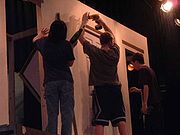
Carpenter (theater)
Encyclopedia

Theatre
Theatre is a collaborative form of fine art that uses live performers to present the experience of a real or imagined event before a live audience in a specific place. The performers may communicate this experience to the audience through combinations of gesture, speech, song, music or dance...
, a carpenter is a stagehand
Stagehand
A stagehand is a person who works backstage or behind the scenes in theatres, film, television, or location performance. Their duties include setting up the scenery, lights, sound, props, rigging, and special effects for a production.-Types of stagehand:...
who builds sets
Set construction
Set construction is the process by which a set designer works in collaboration with the director of a production to create the set for a theatrical, film or television production...
and stage elements. They usually are hired by the production manager, crew chief or technical director
Technical director
The Technical Director or Technical Manager is usually a senior technical person within a software company, film studio, theatrical company or television studio...
and in some less common cases they may be hired by director or producer
Theatrical producer
A theatrical producer is the person ultimately responsible for overseeing all aspects of mounting a theatre production. The independent producer will usually be the originator and finder of the script and starts the whole process...
. They are usually paid by the hour.
Carpenters receive drafting
Technical drawing
Technical drawing, also known as drafting or draughting, is the act and discipline of composing plans that visually communicate how something functions or has to be constructed.Drafting is the language of industry....
from the technical director who uses the designers' renderings, models, and/or drafting of the set to create the technical drawings for the production. Working mainly with wood
Wood
Wood is a hard, fibrous tissue found in many trees. It has been used for hundreds of thousands of years for both fuel and as a construction material. It is an organic material, a natural composite of cellulose fibers embedded in a matrix of lignin which resists compression...
s and metal
Metal
A metal , is an element, compound, or alloy that is a good conductor of both electricity and heat. Metals are usually malleable and shiny, that is they reflect most of incident light...
s, they use techniques that include woodworking
Woodworking
Woodworking is the process of building, making or carving something using wood.-History:Along with stone, mud, and animal parts, wood was one of the first materials worked by early humans. Microwear analysis of the Mousterian stone tools used by the Neanderthals show that many were used to work wood...
and welding
Welding
Welding is a fabrication or sculptural process that joins materials, usually metals or thermoplastics, by causing coalescence. This is often done by melting the workpieces and adding a filler material to form a pool of molten material that cools to become a strong joint, with pressure sometimes...
. They build set pieces, including some standard elements—flats
Flats (theatre)
Flats, short for Scenery Flats, are flat pieces of theatrical scenery which are painted and positioned on stage so as to give the appearance of buildings or other background. They are also called backdrops or backcloths....
, platforms
Platform (theatre)
In theatre, a platform is a stationary, standard flat walking surface for actors to perform on. Typically, they are built to be assembled modularly. They are often used to provide varying levels, to make a show more visually interesting. They are also used to separate areas on stage, and as...
and columns—as well as pieces of the stage
Stage (theatre)
In theatre or performance arts, the stage is a designated space for the performance productions. The stage serves as a space for actors or performers and a focal point for the members of the audience...
. For example, a carpenter may be responsible for building stairs and ramps on and off of the performance area and for leveling the stage floor itself.
Only carpenters trained as riggers are trusted to do rigging (see fly crew
Fly crew
A fly crew is a group of people who operate a fly system from its locking rail during a theatrical production. The responsibilities of a fly crew include bringing battens in and out, keeping the fly system linesets in balance, and ensuring that the fly system's rope locks are applied when the...
). Often union houses and some larger theatres make distinctions between carpenters and riggers, but most smaller theatres do not, due to staffing limitations.
Carpenters do not work on anything with an electrical component (see electrician). They also do not paint the set, as this is the job of a scenic artist
Charge scenic artist
A charge artist leads and oversees the painting of stage, film or television scenery.The charge artist's responsibilities include methods of reproduction of color, texture, preparation and ageing of all surfaces....
.
Often, stage carpentry for a large production is organized with one "master carpenter" or "shop foreman" and many subordinate carpenters.

